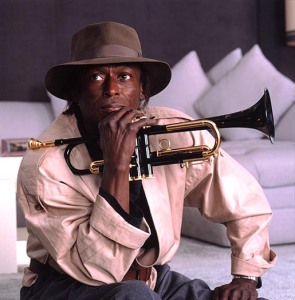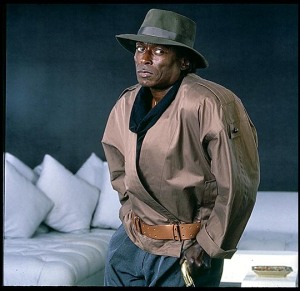MILES DAVIS (part 2/2)
.
Scroll Down to View Photographs Previously Unreleased during original Publication
.
BL!NK: The Many Faces of Miles Davis
By ANTHONY BARBOZA
A coast-to-coast friendship with Miles Davis — a shared love of painting in New York City, a swim while on the job in Malibu California, collaboration on an album cover, and an impromptu hair-cut. _________________________
Date: 1985 Location:
New York City & Malibu, CA
.
Published (The Following Article Recounts the Photo Session of Published Images taken for): LIFE Magazine, The New York Times (Sunday), Essence Magazine, and a Miles Davis Album Cover
..
.
TODAY’S SUBJECT:
Photographer Anthony Barboza recounts spending time in the 1980s with his friend Miles Davis: Stretching canvases in New York for the Jazz Musician’s shared love of painting, photographing the musical legend
at home, at work, and swimming at leisure in Malibu California.
Click HERE to return to Part 1 of this 2 Part Series.
.
BL!NK: The Many Faces of Miles Davis
This is Article #4 of BL!NK: a Photographer’s Experience Between Exposures
story accounted by ANTHONY BARBOZA
as told to SEAN MCCARTHY
.
The phone rings.
Miles: “Tony, what are you doing?”
Tony: “Photographing women.”
Miles: “Are they fine?”
Tony: “Of course they are. What are you doing?”
Miles: “I’m PAINTING women, and they’re dancing all around the canvas.”
.
A Note On: MUSICIAN MILES DAVIS
AND HIS INTEREST IN THE ART OF PAINTING
“Miles Davis began painting in the early 1980s. I was also a painter and he would occasionally call me and ask me to stretch canvases for him. He liked my canvases because they were sturdier than the flimsy ones they sell in the stores. Some of the paintings he did on my canvases would eventually be used as covers for some of his albums.

(Image Above) Artwork by photographer Anthony Barboza,
derived from his photographic portrait of Miles Davis taken in Davis’ home in Malibu.
.
“In May of 1984, Essence Magazine called me to do a shooting of Miles [Barboza and Miles’ second collaboration for the magazine]. At this time, he was living in an apartment on Fifth Avenue in New York City.
“When I first walked in, I noticed many paintings hanging on the walls, and there were many different-colored horns displayed around the living room. There were gold, silver, red, blue and black ones.
“The shoot turned out to be about three hours and was very uneventful. We did most of the shoot in his living room, which was kind of small. We did shots of him both sitting and standing, with a hat and without a hat. He did whatever I asked him to do. It was uneventful.
“Then, in May of 1985, The New York Times (Sunday) Magazine told me they were doing a story on Miles who, at the time, was living in Malibu, Calif. So I flew out there with my wife, (actress) Laura Carrington, and we drove up the highway to this beautiful home on the beach.
“Whoa! What a gorgeous house! We parked our rental car outside, next to Miles‘ Lamborghini. (Miles eventually told me a story about the car, about how the Los Angeles police pulled him over one day because they thought that a black man in a sports car must have stolen it.)
“Miles‘ living room looked out over the Pacific Ocean and it was absolutely beautiful. Laura soon began a conversation with Miles‘ wife, (actress) Cicely Tyson. Cicely was a health nut and was telling Laura about all the different vegetable and fruit drinks she would make for Miles to help him get into shape.
“So as the women talked, Miles said that we had to go to the pool at Pepperdine University (in Malibu) for his morning swim. The outdoor pool was less than a mile from his house, but we chose to take my rental car instead of the Lamborghini. I took my camera, and when we got there Miles took off his street clothes. I was amazed at how thin he was. I was also impressed with his skin — it was fabulous, and his coloring was beautiful. He was very fit and trim. He also wore two beautiful gold necklaces around his neck.
.
Click Image For a Larger View
“Miles began to do lap after lap. He eventually told me that he swims a mile every morning. I photographed him swimming back and forth. After he got out of the pool, he asked me to untangle the elastics he used to tie his hair back. I said, ‘Miles, I can’t get these out.’ So he said, ‘We’ll have to go to the hair dresser.’
“So we drove from the pool to the Watts neighborhood in Los Angeles, which is kind of a dangerous place. When we got there, we parked in front of the hair salon and there was this big, heavy black woman who was very tall. She immediately said to Miles, ‘What the heck did you do with your hair?!’ She slapped him in the back of the head. She was tough, but he was very cool.
“As she was working on his hair, Miles asked me to go get some chicken for us. It was about lunch time. When I went outside and put the key in the car, I noticed Miles‘ wallet on the passenger seat. It had fallen out of his pocket. It was just sitting there totally visible in this dangerous neighborhood. There were five 100-dollar bills in it.
“When I returned with the chicken, he was about done with his hair, and the lady was still yelling at him to take better care of his hair. I remember how he kept his cool when she was so rough with him. That amazed me.
“When I walked back into the salon, I said, ‘Miles, I found your wallet.’ He swiped it from my hand very quickly and didn’t say anything. That also amazed me. He seemed a little embarrassed about it.
“When we got back, Cicely was continuing to give Laura a lot of talk about living healthy. It had been about three hours. Miles told Cicely, in a humorous fashion, that, ‘Tony got my hair all messed up and we had to go to the salon. It was all tangled-up!’ ”
“When we resumed the shoot, I was happy with the results we were getting. One of the best shots was a nice, tight head shot of him that was eventually chosen for the New York Times Magazine. That shot was also used by LIFE Magazine for their edition of ‘Year’s Best Photographs’. We wrapped up that day of shooting at around 5 o’clock.
.

The image above of Miles Davis was taken by photographer Anthony Barboza in 1985 at the trumpeter’s Malibu home. The photograph appeared in The New York Times (Sunday) Magazine as well as LIFE Magazine’s special edition on ‘The Year’s Best Photographs’.
Click Image For a Larger View
“The conversation that I recall so vividly from that shoot was listening to Miles talk about how great Prince was as a musician and he was excited about working with him. He also told me that he mainly listened to the pop music of the day rather than contemporary jazz musicians. He was always trying to find out what’s going on in the world of music.
“My fifth and final shooting of Miles came in June of 1985. Miles called me and said in that deep hoarse voice of his, ‘Barboza, I want you to do the cover for my next album. I don’t want the art director from Columbia Records to do it.’
“Miles told me that the album was going to be called ‘You’re Under Arrest.’ He said he wanted the two of us to collaborate on it. I told him that I would come up with some ideas. I was very excited.
“We started shooting on June 25, 1985, in my New York studio. Although he hadn’t finished the music for the album yet, he wanted to work on the cover. A couple of days later the art director from Columbia called me up and was saying, ‘This is reverse racism!’ I told him that I had nothing to do with it, that Miles asked me to do it.
“When Miles came for our shoot he had recently worked with the world-famous photographer Irving Penn for one of his album covers. There was some tension between the two because Miles wanted music to be played during the shoot and Penn did not. The Penn shots came out great, but I told Miles that I would definitely play music for our shoot. That was the way we always worked.
.
Click Image For a Larger View
“We spent the entire day shooting ‘You’re Under Arrest,’ working on the concept. I had bought two toy guns — one machine gun and one hand gun. I used a red background to symbolize blood. He brought with him two very expensive-looking black jackets, one with a phoenix embroidered on it and the other with gold and silver inlay. We did some shots with a black hat and used the black horn decorated with gold half moons and stars, with the word ‘Miles‘ written inside the rim. We did some nice shots of him putting the mouthpiece of the horn right under his eye. We had a tremendously creative day working as a team.
“It would be the last time I collaborated with Miles. He died in 1991. I cried that day.”.
.
.
BL!NK, A Photographer’s Experience Between Exposures
This article is the fourth installment of our monthly feature, republished here at the BL!NK online archive. Return to this site to view more articles in their re-release, now with new exclusive images and extras.
BL!NK
BL!NK, originally a printed monthly feature in South Coast Today, shares the recollections of Photographer Anthony Barboza, as told to writer Sean McCarthy, along with photos of some of his world-famous subjects from throughout his long and illustrious career.
THIS MONTH’S SUBJECT
Anthony Barboza first met Miles Davis in 1971 and the two became friends over the course of the years and five photo shoots. In today’s monthly installment, the second of two parts, Barboza recalls a more intimate Miles, one who needed help untangling his hair after a swimming session and left his cash-filled wallet in an unlocked car – and was tight-lipped about its safe return.
.
NEXT MONTH’S SUBJECT
Mikhail Gorbachev, former president of the Soviet Union














